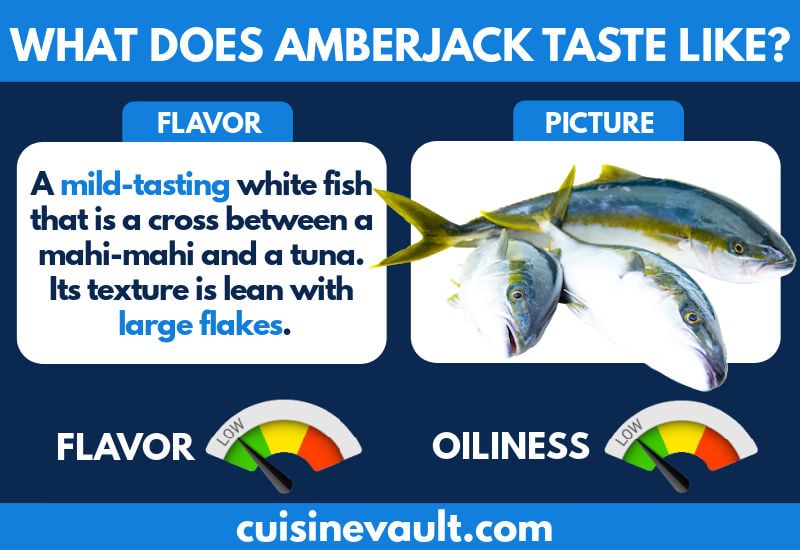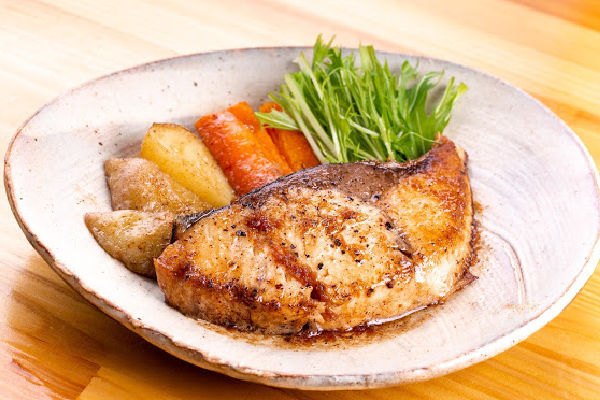The amberjack is a colorful looking fish, sporting a blueish-green back with a yellow band running from its mouth to tail. They vary in size depending on the species and can weigh over 150 pounds.
Are you interested in buying this fish at a restaurant or looking to catch some on your next fishing trip? Is so, you probably want to know what does amberjack taste like? Is it worth eating or are there better options out there? We’re about to take a close look at the fish’s flavor, texture, and uses in the kitchen. Let’s dive in.
Describing the flavor
The amberjack is a mild-tasting white fish that is a cross between a mahi-mahi and a tuna. Its texture is lean with large flakes and has a steak-like consistency like a swordfish, although juicier and more succulent. Compared to a grouper, the amberjack’s texture is a little tougher.
Size will play a big part in the fish’s taste. As it grows, so too does its flavor intensity. The best eating specimens are small, with a milder taste. If you’re out fishing and hook an amberjack, watch out for the larger ones as they’re mostly riddled with parasitic worms in the tail section. For those with a strong stomach, simply chop off the tail section and check the rest of the fish to ensure it is worm-free.
 Recreational anglers are divided on whether the amberjack is a good fish to eat. This is partly because the fish varies in flavor depending on its size. Also, certain parts of the fish are better for eating. The best meat is the steaks that come from the loins, providing mild fillets with large flakes. Other sections, such as the belly, are edible but less appetizing. The bloodline (red line of meat) should be removed for food safety reasons and because most find it unpleasant to eat.
Recreational anglers are divided on whether the amberjack is a good fish to eat. This is partly because the fish varies in flavor depending on its size. Also, certain parts of the fish are better for eating. The best meat is the steaks that come from the loins, providing mild fillets with large flakes. Other sections, such as the belly, are edible but less appetizing. The bloodline (red line of meat) should be removed for food safety reasons and because most find it unpleasant to eat.
Flavor summary
| Feature | Description |
|---|---|
| Flavor | Mild-Medium |
| Texture | Firm, flaky |
| Fishiness | Low-Medium |
| Oiliness | Low |
| Color (cooked) | Creamy white |
Recommended seasoning
Tender, fresh amberjack is a pleasant tasting fish on its own or with a splash of olive oil and some salt and pepper. For extra flavor, try these herbs and spices:
- Dill
- Paprika
- Chili
- Cilantro
- Basil
- Garlic
- Salt and pepper
Best side dishes
Amberjack works well with a wide variety of flavors. Get creative with your side dishes but try not to overwhelm this mild-flavored fish. Try a selection of these:
- Potatoes
- Pasta
- Garden salad
- Grilled vegetables
- Coleslaw
- Fries
Choosing a good fish
If you’re looking to buy whole amberjack at your local fish market, look for one that has a mild aroma, a lot like the ocean. Anything more pungent should be avoided. Find fish with a shiny surface, tight scales, and deep red gills. There should be no signs of slime or cuts in the skin.
If you decide to buy fresh steaks or fillets then they should be firm with no discoloration. Fresh flesh has a translucent color with a mild aroma.
Grilled amberjack recipe
Rest the fish in a marinade for 30 minutes to add a deliciously fresh, clean taste to your meal. This is a simple, quick recipe for grilling amberjack.
 Serves: 4 people. Prep Time: 30 minutes. Cook Time: 8 minutes
Serves: 4 people. Prep Time: 30 minutes. Cook Time: 8 minutes
Ingredients
- 1 Tbsp sugar
- ⅓ cup red wine vinegar
- ⅓ cup lemon juice
- 1 tsp fresh thyme
- 1 tsp Worcestershire sauce
- 3 cloves garlic
- Pinch of salt
- 4 amberjack steaks
- Salt and pepper, to taste
Instructions
- Combine sugar, vinegar, lemon juice, thyme, Worcestershire sauce, garlic, and salt in a shallow dish.
- Place the fish in the marinade, turning to ensure all the fish is coated in sauce.
- Marinate for 30 minutes, turning at the halfway point.
- Preheat the grill to a medium-high heat, season the fish with salt and pepper and then add to the grill. Cook each side for four minutes or until the flesh appears opaque and easily pulls apart in flakes.
Notes:
-Instead of using a shallow dish, you can add the fish and marinade to a plastic bag.
-Thin fillets that are under a ½ inch thick do not need to be turned during cooking.
-Cooking times will vary depending on the thickness of the fish. Avoid overcooking as it will become tough and dry very quickly.
Other cooking options
The flesh of amberjack is very firm, making it suitable for steaming, baking, and poaching. It also holds together well in chunks added to kabobs or fish stew. Common methods of cooking fish like grilling, broiling, smoking, and pan-frying will also yield great results.
Whichever method of cooking you choose, leftover fish is excellent chilled and used in tuna subs or tuna bakes as a substitute for canned tuna. The fish can also be broken into salads and sauces or used as a key ingredient in seafood chowder.
Recommended reading:
What do barracudas taste like?
What do walleyes taste like?
Fast facts about amberjacks
- They are a strong fighting game fish that can be a challenge to pull into the boat.
- Varieties of amberjack include the greater amberjack, lesser amberjack, and rudderfish from the Atlantic. The Almaco Jack and yellowtail are commonly caught in the Pacific.
- Useful substitutes include the tilefish, shark, mahi-mahi, or mullet.
- The greater amberjack prefers to live around shipwrecks, bridges, and reefs while lesser amberjacks prefer the deeper water. They feed on fish, squid, and crustaceans.
- Amberjacks are members of the Carangidae family.
 Summing up
Summing up
The amberjack is a divisive creature in the fishing world – some love it, others loathe it. Game fishermen chasing shark, tuna, or barracuda will often toss amberjacks back into the water if they inadvertently hook one. Although some people really enjoy them, most would agree that they’re no comparison to tuna, mahi mahi, or wahoo.
Everyone has different tastes and you may love this fish, so we recommend trying it once. It has a more intense flavor than other options like red snapper or haddock so it may not be ideal for those with a sensitive palate.
What is your favorite game fish and what makes it so special? Please let us know in the comments below.

Leave a Reply